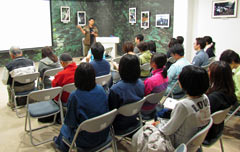Okinawa rail threatened by increase in mongoose numbers

Research findings regarding birds unique to the Yambaru are explained at a local briefing session at the Yambaru Wildlife Center in Kunigami Village.
May 16, 2011 by Katsuyoshi Oshiro, correspondent of the Ryukyu Shimpo
The Yambaru Wildlife Center in Kunigami Village held the local briefing session on the wildlife in the Yambaru that had been announced at the 58th National Convention of Ecological Society of Japan held in Sapporo, Hokkaido in March.
Nobuhiko Kotaka, a senior researcher of the Kyushu Branch of the Forestry and Forest Products Research Institute, explained the impact of non-native species such as the mongoose on three birds unique to the Yambaru: the Okinawa woodpecker, the Okinawa rail and Stejneger’s Ryukyu Robin. It is reported that the mongoose has had the greatest impact on the Okinawa rail and that the range of mongoose activity has been expanding.
In 2007 and 2010, Kotaka carried out studies of the distribution of the three species of birds using Playbak, a method of surveying wildlife in which the animals or birds respond to calls generated by a special audio device.
Kotaka analyzed the capture-efficiency of mongooses using Ministry of the Environment (MOE) data from geographic information systems that can provide information on the vegetation cover area and height above sea level, and capture data of non-native species gathered by the MOE and Okinawa Prefectural Government in 2006.
It is estimated that the population of the Okinawa woodpecker and Stejneger’s Ryukyu Robin is concentrated in the areas where the mongoose population is low and where there is a thicker coverage of evergreen broadleaf forest in places higher above sea level.
The number of mongooses has impacted most dramatically on the population of Okinawa rail. While mongoose numbers had less impact on the population of Okinawa woodpecker and Stejneger’s Ryukyu Robin in 2010 compared with 2007, their influence on the population of the Okinawa rail is estimated to increase in the area centered on Higashi Village.
Kotaka reported that the population of the three birds was high in the areas at not so far above sea level in 2010 compared with 2007 indicating a change in the range of habitation.
(English Translation by T&CT, Mark Ealey)
Previous Article:Extra edition: relocation of Futenma Air Station unrealistic
Next Article:Protest rally marks the 30th anniversary of Okinawa’s return to Japan
[Similar Articles]
- Pair of Yambaru kuina found in Ogimi for the first time in 12 years
- A walk through vibrant forest along Arakawa gawa and Fun gawa
- Noguchigera released after road accident
- Okinawa woodpecker habitats move south to Nago area
- Twenty-Four Accidents Involving Yambaru Kuina This Year More Accidents than Last Year, Clinics are “At Capacity”
 Webcam(Kokusai Street)
Webcam(Kokusai Street)


